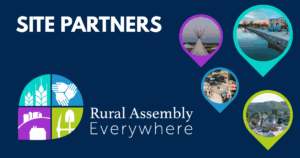Rural schools are sick, and it’s not just the coronavirus. As the nation’s gaze turns to the reopening of schools this fall, we must realize that safe and accessible education is still an elusive promise for millions of America’s kids, virus or no.
It’s taken only a few months for Covid19 to expose the injuries and inequities that plague many of America’s institutions, and with the return of school, we’ll watch in real time how lack of investment in our public education system cuts across geography and demographics.
In small towns and rural communities, especially in the South and on tribal lands, school districts are struggling to gear up—literally—to confront an uncontrolled pandemic, while simultaneously navigating decades of disinvestment and disrepair. When in-person instruction resumes, parents, teachers, and administrators will face the coronavirus, as well as the groans and sighs of buildings, some of which are more than 70 years old.
The Challenge: Deep and Persistent Inequities
The struggle on the ground is real. Strained conversations are happening around kitchen tables all over the country as families grapple with the decision to send their children back to school. Uncles and aunts, parents and grandparents have become frontline epidemiologists, weighing risks and exploring every scenario for safe re-entry to school.
But in the rural counties that serve majority black, brown and Indigenous children, efforts to make classrooms Covid-safe collide with a backlog of inequities reaching back to Jim Crow. Teachers and families in rural districts are worried about Covid19, to be sure, but they’re also wearied by historical racism and marginalization, which look a lot like rusted pipes and empty Wi-Fi bars on a laptop.
While we know that more than half of public school districts need updates or repairs, there is no national database for keeping track of the conditions of buildings and technology. The Center for American Progress estimates it will take nearly $200 billion to make public school buildings safe, but the absence of a centralized accounting system makes it harder to address these disparities or build a structure for equitable funding.
Teachers and families in rural districts are worried about Covid19, to be sure, but they’re also wearied by historical racism and marginalization, which look a lot like rusted pipes and empty Wi-Fi bars on a laptop.
While we know that more than half of public school districts need updates or repairs, there is no national database for keeping track of the conditions of buildings and technology. The Center for American Progress estimates it will take nearly $200 billion to make public school buildings safe, but the absence of a centralized accounting system makes it harder to address these disparities or build a structure for equitable funding.
To add insult to injury, there is no permanent funding mechanism for school infrastructure at a federal level. Less than 1 percent of funding for school infrastructure comes from federal sources with the rest from state and local governments. Rural districts without adequate local funding rely on state funds for infrastructure.
According to the Bipartisan Policy Center, districts with high-poverty rates spend 16 percent less per student than wealthier districts. When state education funding is cut, infrastructure funding is often the first to go. This places local school boards back at the proverbial kitchen table, wrestling over the untenable cuts that will harm the communities they seek to serve.
Assembling for Solutions—The Time is Now
Rural Americans know that local schools are indispensable community hubs and economic centers, providing services that extend beyond the walls of the classroom. They are on the frontlines of the racial wealth gap in this country, and in many cases, provide healthcare services, food security to families, and a pathway to civic engagement. They serve as polling stations, as a distribution point for vaccines, as sources of community news. Like giant oak trees in an old growth forest, rural schools mark time by decades and generations, a constant presence in community life.
Like giant oak trees in an old growth forest, rural schools mark time by decades and generations, a constant presence in community life.
In early July, the Rural Assembly, a movement of rural advocates and organizations, partnered with the Southern Rural Black Women’s Initiative to convene 35 rural leaders and school advocates in a virtual meeting to name what it will take to make rural schools safer and better equipped. The stakes feel high, and the necessary solutions often feel out of reach, too.
Roundtable participants joined from across the country, from the borderlands in Texas to Northern California to the Mississippi Delta. They came with a shared understanding of the critical role public education and local schools play in addressing some of the most intractable issues of our time, and they came with a burning desire to make the case for more investment.
The conversation quickly turned to the lowest hanging fruit: the immediate promise of the next stimulus package.
U.S. Representative Bennie Thompson (D-MS) noted a key challenge for rural schools is that funding is tied to student enrollment rather than need. Rep. Thompson is part of a growing chorus of policymakers trying to shift the funding strategy from population density to focusing on communities of persistent poverty, especially those that have historically been underserved in regions, like the Delta, and on tribal lands, where systemic inequities fall along lines of race and income.
In the short term, stimulus dollars should prioritize rural school infrastructure for those high-poverty communities. These dollars would help support strategies for virus mitigation, including broadband connectivity, proper air ventilation, and safe learning in reopened classrooms.
But that is just a first step.
Rural advocates say we need a longer-term vision and commitment to funding public schools that is driven by local, state, and federal partnerships and looks a lot like a current piece of legislation that is now making its way through Congress: The Reopen and Rebuild America’s Schools Act (RRASA) contains provisions which will help to address the long-standing deficits to our nation’s public K-12 infrastructure. Advocacy groups like [Re]Build America’s School Infrastructure Coalition (BASIC) are leading the charge to assemble voices in support of federal funding that prioritizes high poverty districts and fixes what is broken.
This moment calls for a broader vision for rural America, which includes a robust public education system that serves communities and families in every valley, prairie, and holler.
We stand at the crossroads of a global pandemic and a movement for racial justice and repair. The sighs of old buildings and the whispered worries of families sitting around kitchen tables demand an end to racist systems and investment in restorative ones. It’s time to redress the national promise of providing quality public education to all, no matter the zip code.
Endorsed by
Organizations:
Action Communication and Education Reform, Inc.
The Arcola Voices
Alabama Arise
Appalshop
Bama Kids, Inc. (Camden, AL)
California Teachers Association Retired- Redding Chapter
The Canyon School
21st Century Schools Foundation
The Center for Rural Strategies
Children’s Defense Fund, Southern Regional Office
A Colony of Women
EcoRise
Foundation for the Mid South
Kentucky Valley Educational Cooperative
Lexington Colts Youth Sports
Mind Changes Mentoring Program (Tuscaloosa, AL)
North Bolivar Consolidation School District
National Indian Education Association
National Rural Education Association
Nollie Jenkins Family Center, Inc.
One Voice
Parents for Public Schools
Quitman County Development Organization
The Southern Rural Black Women’s Initiative for Economic and Social
Justice (SRBWI)
Individuals:
Adrian Billings, MD, PhD, FAAFP; Alpine, TX
Rita Bissell; Smithville, MS
Bethany Chaney; Carrboro, NC
Honorable Briana Westry-Robinson, Wilcox County District/Juvenile
Judge (Camden, AL)
Richard Critelli; Fort Valley, VA
Debra Dace; Greenville, MS
Larry Dreiling; Hays, KS
Carolyn Fowler; Inglewood, CA
Jim Fredericksen; Boise, ID
Pamela Guthman; Holcombe, WI
Renalda Jaynes; Jackson, MS
Laura Matura; Canton, TX
Cheryl McKinley; Redding, CA
Diane Moore; Davis, CA
Deborah Moore; Cleveland, MS
Leah Reasor; Maynardville, TN
Bruce Rosen; New York, NY
Mollie Rowe; Eutaw, AL
Betsey Russell; Asheville, NC
Alderman Clarence Scutter; Port Gibson, MS
Gloria Shields; Yazoo City, MS
Nancy Simerl; Sherburne, NY
Deborah A. Thomas; Pelham, AL
The Southern Rural Black Women’s Initiative Human Rights Commission Leads:
Alicia Foster – Wilcox County (AL)
Annie Robinson – City of Hayneville (AL)
Barbara Brooks – Leland (MS)
Bobbie Miller – Isola (MS)
Cora Burnside – Arcola (MS)
Darlene Robinson (Green County – AL)
Eulah Peterson – Bolivar County (MS)
Mary Moncrease – Conechuh County (AL)
Nettie Lilly – Baker County (GA)
Olivia Pearson – Coffee County (GA)
Shaquita Allen – Metcalfe (MS)







